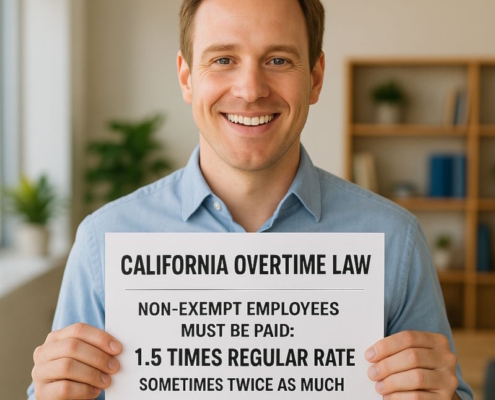What is hourly to salary?
Hourly to salary means converting an employee’s hourly pay to salary. To calculate hourly to salary, add the total hours an employee works per year, and multiply it by the employee’s hourly wage. For example: for an employee who is paid $20/hr and works 1500 hours, the hourly to salary conversion is: 1500 hours X $20 per hour = $30,000.

Author: Brad Nakase, Attorney
Email | Call (800) 484-4610
Dollars per hour salary describes how much an hourly worker would make if their employer paid them a yearly salary.
This calculation is called an “hour-to-year conversion” and adds up the person’s annual income.
In this article, our business lawyer in Los Angeles will explain the hourly to the salary concept and provide examples of dollars per hour salary, also known as hourly to yearly, as follows:
How to convert hourly to salary?
Hourly to salary refers to the act of taking a worker’s hourly pay and computing what their yearly pay projection would be.
When a worker wants to see what their dollars per hour salary would become if they were paid a yearly salary, they calculate their hourly to yearly salary.
Here is how a worker can use this equation to calculate their projected yearly pay:
First, how many hours does the person work?
To find this out, multiply the number of hours the individual works in a week times the number of weeks in a year.
For example, if the person works 20 hours per week, they would multiply 20 X 52 for 1040 hours.
Next, the employee divides this number by their annual “salary” or the amount they make per year currently.
If the employee makes $30,000 per year, for example, divide $30,000 by 1040 for $28.85.
Why do employees compare hourly to salary payments?
The hourly to yearly formula allows individuals to benchmark effectively. Some hourly employees, for example, wish to compare their pay to peers or friends who are on salary in order to see where their salaries rank within their industry.
Can individuals convert their yearly salary to an hourly pay rate?
Sometimes, salaried employees want to see what their hourly pay would be in unadjusted form. When they do, they use a specific formula.
The formula is slightly different from the “hourly to yearly” formula, but it is still easy.
First, identify the number of hours the individual works in one day. Then, multiply that number by the number of days the individual works per year.
For example, if the person works 8 hours per day, 200 days per year, that is 1600 hours.
Next, divide the person’s salary (in this case, 1600 hours) by the above figure. In this case, let’s say the person’s salary is $40,000 annually.
Divide $40,000 by 1600; the resulting figure, $25, is the person’s hourly wage.
In this case, the $25 per hour is the person’s gross pay, not take-home pay. Therefore, when their employer takes out deductions, their net pay will amount to less than $25 per hour.
Why Contact a Professional Attorney in California
For questions about pay rates in California, contact the licensed professionals at Nakase Wade.
Our California business lawyers and corporate attorneys provide legal counsel to employees and business owners throughout the state, and we offer free consultations.
For questions about compensation or problems with pay rates, contact us today.
Have a quick question? We answered nearly 2000 FAQs.
See all blogs: Business | Corporate | Employment
Most recent blogs:

AB 1228 Summary: California Fast Food Law on Wages, Council Authority, and Business Impact

Can a 13 Year Old Work? 14 Real Ways for Young Teens to Earn Money Safely

Severance Pay California: What It Includes and How to Change the Terms

Employment Litigation: Key Issues in Job Termination, Discrimination, and Harassment Cases

Company Morale: 20 Practical Ways to Improve Workplace Culture and Engagement

California Mileage Reimbursement 2025: Rate Details, Methods, and Employer Duties

Temporary Disability California: Workers’ Compensation Coverage, Benefit Limits, and Qualifying Conditions

Legal Age to Work in 2025: Employment Limits for Minors

Abusive Conduct Under California Law: Definition, Workplace Examples, and Employer Obligations

Minimum Wage in San Diego 2025: Updated City and County Pay Rates for Employers

California Labor Law: 2025 Employer & Employee Guide to Wages, Breaks, Leave, and Rights

California Final Paycheck Law: Payment Timelines, Legal Rules, and Employer Responsibilities

Can You Work at 14 in California? Laws, Restrictions, and Permits for 14- and 15-Year-Olds

How Many Hours Is a 9-5 Job? Daily, Weekly, Monthly, and Yearly Breakdown

Exempt Employee California: 2025 Rules, Salary Thresholds & Classification Tests Explained

Fair Chance Employers: A 2025 Guide to Compliant and Inclusive Hiring Practices

PAGA Claims in California: How Workers Can File and What Penalties Employers Face

How Many Hours Can a 16 Year Old Work? A Complete Guide to U.S. Child Labor Laws

New Hire Forms Checklist: Required Documents & Onboarding Essentials for Employers

Comp Day Explained: Eligibility, Benefits, and How to Calculate It Correctly

Work Permit California: Requirements, Age Limits, and Job Restrictions for Minors

Split Shift Meaning Explained: How It Works, Benefits, Laws, and Real-World Examples

Is California an At-Will State? 4 Key Exceptions You Need to Know

California Pay Data Reporting: 2025 Deadline, New MENA Category, and Updated Filing Requirements

Family Leave California: Paid Family Leave Benefits, Eligibility, and Updates for 2025

California Child Labor Laws: Key Rules About Work Permits, Hours, and Restrictions for Minors

California Minimum Wage Increase 2025: New Rates for State, Fast Food, Healthcare, and Localities

Background Check California: Laws, What Shows Up, and How to Clear Your Record

How Many Hours Can a Minor Work in California? A Complete Guide to Labor Laws and Restrictions

